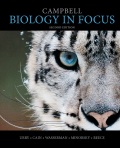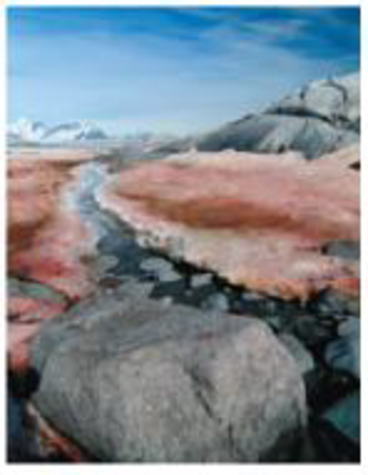
EBK CAMPBELL BIOLOGY IN FOCUS
2nd Edition
ISBN: 8220101459299
Author: Reece
Publisher: PEARSON
expand_more
expand_more
format_list_bulleted
Concept explainers
Textbook Question
Chapter 8, Problem 14TYU
SYNTHESIZE YOUR KNOWLEDGE

“Watermelon snow” in Antarctica is caused by a species of photosynthetic green algae that thrives in subzero temperatures (Chlamydomonas nivalis). These algae are also found in high-altitude year-round snowfields. In both locations, UV light levels tend to be high. Based on what you learned in this chapter, propose an explanation for why this photosynthetic alga appears reddish-pink.
Expert Solution & Answer
Want to see the full answer?
Check out a sample textbook solution
Students have asked these similar questions
“Watermelon snow” in Antarctica is caused by a certain species of photosynthetic green algae that thrives in subzero temperatures (Chlamydomonas nivalis). These algae are also found in high-altitude, year-round snowfields. In both locations, Uv light levels tend to be high. Propose an explanation for why this alga appears reddish-pink.
Watermelon snow” in Antarctica is caused by a species of photosynthetic green algae that thrives in subzero temperatures (Chlamydomonas nivalis). These algae are also found in high altitude year-round snowfields. In both locations, UV light levels tend to be high. Based on what you learned this week, propose an explanation for why this photosynthetic alga appears reddish-pink.
"Watermelon snow" in Antarctica is caused by a species of photosynthetic green algae that thrives in subzero temperatures (Chlamydomonas nivalis). These algae are also found in high altitude in year-round snowfields. In both locations, UV light levels tend to be high. The reddish-pink color of these algae is due to the presence of carotenoid pigments, which absorb blue light while reflecting red light. Those pigments protect the chloroplast from ultraviolet radiation, as well as absorbing heat, which provides the algae with liquid water as the snow melts around it. This molecular variation in plants illustrates
a
relative fitness because the molecular adaptations in chlorophyll pigments have passed to the next generation
b
innate variability because plants have evolved molecular differences to an environmental stimuli
c
unselective adaptation because plants have evolved molecular differences to adapt to different wavelengths of light
d
inclusive…
Chapter 8 Solutions
EBK CAMPBELL BIOLOGY IN FOCUS
Ch. 8.1 - How do the reactant molecules of photosynthesis...Ch. 8.1 - How did the use of an oxygen isotope help...Ch. 8.1 - WHAT IF? The Calvin cycle requires ATP and NADPH,...Ch. 8.2 - What color of light is least effective in driving...Ch. 8.2 - In the light reactions, what is the initial...Ch. 8.2 - Prob. 3CCCh. 8.3 - MAKE CONNECTIONS How are the large numbers of ATP...Ch. 8.3 - WHAT IF? Explain why a poison that inhibits an...Ch. 8.3 - Prob. 3CCCh. 8 - The light reactions of photosynthesis supply the...
Ch. 8 - Which of the following sequences correctly...Ch. 8 - How is photosynthesis similar in C4, plants and...Ch. 8 - Which of the following statements is a correct...Ch. 8 - Which of the following does not occur during the...Ch. 8 - In mechanism, photophosphorylation is most similar...Ch. 8 - Prob. 7TYUCh. 8 - To synthesize one glucose molecule, the Calvin...Ch. 8 - SCIENCE, TECHNOLOGY, AND SOCIETY Scientific...Ch. 8 - DRAW IT The following diagram represents an...Ch. 8 - Prob. 11TYUCh. 8 - Prob. 12TYUCh. 8 - FOCUS ON ENERGY AND MATIER Life is solar powered....Ch. 8 - SYNTHESIZE YOUR KNOWLEDGE Watermelon snow in...
Additional Science Textbook Solutions
Find more solutions based on key concepts
More than one choice may apply. Using the terms listed below, fill in the blank with the proper term. anterior ...
Essentials of Human Anatomy & Physiology (11th Edition)
Gregor Mendel never saw a gene, yet he concluded that some inherited factors were responsible for the patterns ...
Campbell Essential Biology (6th Edition) - standalone book
2. A gene is a segment of DNA that has the information to produce a functional product. The functional product ...
Genetics: Analysis and Principles
Why is it unlikely that two neighboring water molecules would be arranged like this?
Campbell Biology (10th Edition)
The pedigrees indicated here were obtained with three unrelated families whose members express the same disease...
Genetics: From Genes to Genomes
Knowledge Booster
Learn more about
Need a deep-dive on the concept behind this application? Look no further. Learn more about this topic, biology and related others by exploring similar questions and additional content below.Similar questions
- The main product of fossil fuel combustion is CO2 , and thisis the source of the increase in atmospheric CO2 concentration. Scientistshave proposed strategically situating containers of these algae near industrialplants or near highly congested city streets. Considering the process ofphotosynthesis, how does this arrangement make sense?arrow_forwardChemolithrophs near hydrothermal vents support a variety of other life forms there. Explain now their role is analogous to that of photosynthetic organisms in the terrestrial environment.arrow_forwardWhich of the following prokaryotes has a relatively large surface-to-volume ratio for rapid gas exchange, despite having one of the largest cytoplasmic volumes of any known eubacterial cell? the archaeobacterium Halobacterium halobium the archaeobacterium Nanoarchaeum equitans the eubacterium Rhodopseudomonas viridis the eubacterium Epulopiscium fishelsoni the eubacterium Escherichia coliarrow_forward
- Compare photo litho autotrophy with chemo-organo heterotrophy. Sun light is the ultimate source of energy and all living organisms obtain their energy directly or indirectly from the sun. However in deep-sea vents (where there is no sun light) life has originated and the many groups of microorganisms are flourishing in such environment. How? Explain your reasoningarrow_forwardTurbidity affects light penetration. Discuss how this impacts the growth and reproduction of the algae and cyanobacteriaarrow_forwardDinoflagellates are unicellular, marine protists. Dinoflagellates are bioluminescent, but only at night. During the day, they carry out photosynthesis similar to other autotrophs. At night, however, they bioluminesce every time they are disturbed. They are often seen in the wakes of ships at night. While the reason for this bioluminescence is not fully understood, many scientists concur that it is a form of self-defense. If small fish begin to feed upon the protists, the protists will begin to bioluminesce. These flashes of light in the dark water can alert larger fish and draw them towards the small fish, upon which they prey. By making the small fish vulnerable, the dinoflagellates are able to protect themselves. Based on the information above, a researcher decides to design an experiment in which she is testing how long it takes for dinoflagellates to recover after different amounts of disturbance. She maintains 10 containers of dinoflagellates with similar temperature, salinity and…arrow_forward
- How does the life cycle of a typical Red alga (Phylum Rhodophyta) differ from any other life histories covered in the course thus far? Don't forget to highlight these differences by comparing them to the basic types (i.e sporic, gametic, or zygotic meiosis)!arrow_forwardDinoflagellates are unicellular, marine protists. Dinoflagellates are bioluminescent, but only at night. During the day, they carry out photosynthesis similar to other autotrophs. At night, however, they bioluminesce every time they are disturbed. They are often seen in the wakes of ships at night. While the reason for this bioluminescence is not fully understood, many scientists concur that it is a form of self-defense. If small fish begin to feed upon the protists, the protists will begin to bioluminesce. These flashes of light in the dark water can alert larger fish and draw them towards the small fish, upon which they prey. By making the small fish vulnerable, the dinoflagellates are able to protect themselves. Based on the information above, a researcher decides to design an experiment in which she is testing how long it takes for dinoflagellates to recover after different amounts of disturbance. She maintains 10 containers of dinoflagellates with similar temperature, salinity and…arrow_forwardTHIS IS A MULTIPART QUESTION, PLEASE ANSWER ALL QUESTION Using the image: 5. Identify whether the organism is a green alga, a diatom, a dinoflagellate, Eubacterium, or a Cyanobacterium. Explain the characteristic(s) that led you to that identification. 6. a. What type of microscopy (brightfield, darkfield, or phase contrast) was to obtain the image? Explain how you can tell. b. Name a different type of microscopy would be also appropriate to use to visualize the organism in the image. How would the image change if you used that type of microscopy instead? 7. The image was taken using a microscope that has 10X, 40X, and 100X objectives. What is a possible magnification for the ocular lens on this microscope? Explain your response or show calculations.arrow_forward
- What type of bioluminscence produces 1000 photons of light per second in a normal situation without predators? What are some other types of bioluminescent bactirium and how much light do they produce in a normal situation? How many photons are emited by luciferin and luciferase in a normal situation? Amount of light emited per amount of bacterium.arrow_forwardClostridium botulinum is a strict anaerobe; that is, it is killed by the molecular oxygen (O2) present in air. Humans can die of botulism from eating foods in which C. botulism is growing. How does this bacterium survive on plants picked for human consumption? Why are home-canned foods most often the source of botulism?arrow_forwardWhy are Amphotericin B and Azoles selectively toxic for fungus? (Define selectively toxic and explain why Amphotericin B and Azoles will harm fungal cells but not harm humans.)arrow_forward
arrow_back_ios
SEE MORE QUESTIONS
arrow_forward_ios
Recommended textbooks for you
 Biology Today and Tomorrow without Physiology (Mi...BiologyISBN:9781305117396Author:Cecie Starr, Christine Evers, Lisa StarrPublisher:Cengage Learning
Biology Today and Tomorrow without Physiology (Mi...BiologyISBN:9781305117396Author:Cecie Starr, Christine Evers, Lisa StarrPublisher:Cengage Learning

Biology Today and Tomorrow without Physiology (Mi...
Biology
ISBN:9781305117396
Author:Cecie Starr, Christine Evers, Lisa Starr
Publisher:Cengage Learning
6th Grade Science - Module 2: Physical & Chemical Properties; Author: iUniversity Prep;https://www.youtube.com/watch?v=4DONkU6c2Rs;License: Standard youtube license